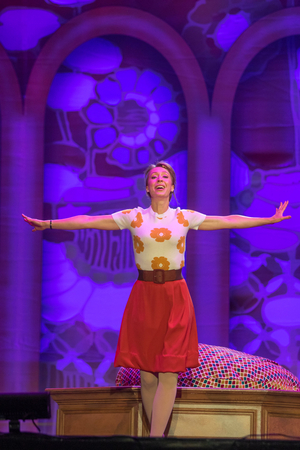Review: THE SAN DIEGO OPERA'S BARBER OF SEVILLE at Pechanga Sports Arena
The colorful production coninues on April 30 and May 1 and stars Emily Fons and David Pershall

The San Diego Opera continued its quixotic foray into parking-lot adventures with The Barber of Seville by Rossini, social distancing once again forcing substantial changes to a production's length and cast size. Revisions to libretto, costumes, set and lighting went all out for a zany farcical effect that even many staid opera lovers of a certain age would eventually realize harkened back to the free-wheeling spirit of Rowan and Martin's Laugh-in, complete with "Sock it to me," chicken jokes and Rowan's trademark closing "Say goodnight, Dick." This always said to his seemingly clueless partner Dick Martin. Lest you think it was a radically revised libretto, I offer assurances that most of the explicit references to the bygone TV show were displayed in hand-drawn lettering on cardboard placards held up by a man near the stage whose humble garb included a Santa Clause hat. This seemingly homeless but cheerful gentleman was teamed offstage with a gaggle of others. Some of them were chorus members, policemen and musicians usually on stage for Rossini's comic opera, but now, during difficult times, especially for opera directors and stage managers, they were singing, dancing and gesticulating wildly offstage, one of them mounted on an old pickup truck.
Mezzo-soprano Emily Fons as Rosina and bass-baritone Patrick Carfizzi as Doctor Bartolo seemed the most at home with exaggerated mugging in facial closeups on the large projection screens at each side of the stage. Carfizzi was last seen in San Diego as the "very model of a modern major general" in The Pirates of Penzance, and a highlight of that production was his tape-recorder-on-fast-forward version of the

Major General's best-known aria. The bass baritone seems a first-call choice for the Met when filling the role of a comic character, and his skill with difficult arias delivered at warp speed served him well in both the aria A un dottor della mia sorte and during rapid interplay among Rossini's main characters as they variously pled their cases, espoused their virtues and mocked each other by imitation.
Happily, the designed mayhem never

interfered with vocal effectiveness. Fons was especially winning as the girlish, spoiled flirt out to win Count Almaviva, even go-go dancing briefly ala Laugh-in's Goldie Hawn. And her delightful acting was easily matched by a smooth agile voice in a highlight coloratura performance of the aria Una voce poco fa.
Baritone David Pershall as Figaro was confident and dashing, slyly charming in his many asides to a

closeup camera, and decidedly masculine in solo arias. Tenor Carlos Enrique Santelli sang Count Almaviva, first disguised as a music teacher because he wants to win Rosina without playing the I'm-a-Count card. He's also out to avoid exposing his quest for marital bliss from doctor Bartolo, who sees himself as his ward's future husband. In an off-the-wall touch that is part of the original story, Almaviva later returns disguised as a soldier with official authorization for temporary housing in the home of Rosina and Bartolo. Need I say, comic complications ensue.
Bass Peixin Chen played Don Basilio with a clear commanding voice. Completing the

main cast in pared-down roles were mezzo-soprano Alexandra Rodrick as Berta, bass-baritone Joshua Arky as Fiorello, and Michael Sokol as the Sergeant. San Diego Opera's Chorus Master and Music Administrator Bruce Stasyna conducted San Diego Symphony musicians who responded with their usual professional aplomb. The mix of sound designer Ross Goldman spotlighted the singers who were all miced. That had the advantage of exceptional vocal clarity, but often turned Rossini's vibrant orchestration into subdued background music.
The Santa-hatted wielder of cardboard placards gave the first clear hint that this was Figaro via Laugh-in. The thought was reinforced with the appearance of 60s hippie-costumes designed by Ingrid Helton. These included the incongruous pool float around the waist of Bartolo's assistant Berta and Bartolo's knitting needles, not to mention the good doctor's rubber chicken, a reminder of "chicken jokes."
Stage Director Keturah Stickann kept the production moving rapidly along. That, combined with the action off stage and the halving of the opera's usual three-hour length meant it was difficult to catch every joke or even, at times, keep up with the accelerated plotline. But it was all in the spirit of the occasion.

A cool breeze visible in the fluttering hair of Fons was one of the disadvantages of opera in a parking lot on this evening. I was relieved to see her with a shawl while in the background. But the singers and musicians overrode all disadvantages in a performance that made the playful Laugh-in tie-in a vibrant entertainment, not all that far off from the effect Rossini and librettist Cesare Sterbini were after with the original opera.
Photos courtesy San Diego Opera
The Barber of Seville will be performed again at the Pechanga Arena, 3500 Sports Arena Blvd., 8:00 pm on April 30 and May 1. For ticket and other information visit San Diego Opera.
Reader Reviews
Videos

